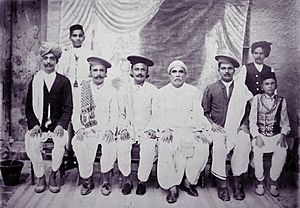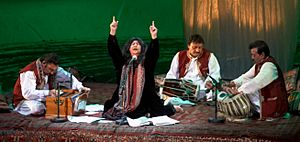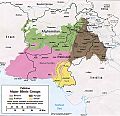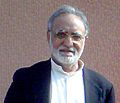Sindhi people facts for kids
| Total population | |
|---|---|
| c. 32 million | |
| Regions with significant populations | |
| 29,500,000 | |
| 2,772,264 | |
| 341,000 | |
| 30,500 | |
| 30,000 | |
| 11,500 | |
| 10,000 | |
| 9,801 | |
| 8,800 | |
| 7,500 | |
| 700 | |
| Languages | |
| Sindhi | |
| Religion | |
| Predominantly Islam Minority Hinduism and Sikhism |
|
Sindhis (Sindhi: سنڌي (Perso-Arabic), सिन्धी (Devanagari), ![]() (Khudabadi)) are an Indo-Aryan ethno-linguistic group who speak the Sindhi language and are native to the Sindh province of Pakistan. After the partition of India in 1947, most Sindhi Hindus and Sindhi Sikhs migrated to the newly formed Dominion of India and other parts of the world. Today, ethnic Sindhis are both in India and Pakistan. Indian Sindhis are predominantly Hindu, while Pakistani Sindhis are predominantly Muslim.
(Khudabadi)) are an Indo-Aryan ethno-linguistic group who speak the Sindhi language and are native to the Sindh province of Pakistan. After the partition of India in 1947, most Sindhi Hindus and Sindhi Sikhs migrated to the newly formed Dominion of India and other parts of the world. Today, ethnic Sindhis are both in India and Pakistan. Indian Sindhis are predominantly Hindu, while Pakistani Sindhis are predominantly Muslim.
Sindhi Muslim culture is highly influenced by Sufi doctrines and principles. Some of the popular cultural icons are Shah Abdul Latif Bhitai, Lal Shahbaz Qalandar, Jhulelal and Sachal Sarmast.
Contents
History
Pre-historic period
The Indus Valley Civilisation went into decline around the year 1700 BC for reasons that are not entirely known, though its downfall was probably precipitated by an earthquake or natural event that dried up the Ghaggar River. The Indo-Aryans are believed to have founded the Vedic civilisation that existed between the Sarasvati River and Ganges river around 1500 BC. This civilisation helped shape subsequent cultures in South Asia.
Historical period
For several centuries in the first millennium B.C. and in the first five centuries of the first millennium A.D., western portions of Sindh, the regions on the western flank of the Indus river, were intermittently under Persian, Greek, and Kushan rule, first during the Achaemenid dynasty (500–300 BC) during which it made up part of the easternmost satrapies, then, by Alexander the Great, followed by the Indo-Greeks, and still later under the Indo-Sassanids, as well as Kushans, before the Islamic invasions between the 7th–10th century AD. Alexander the Great marched through Punjab and Sindh, down the Indus river, after his conquest of the Persian Empire.
Sindh was one of the earliest regions to be conquered by the Arabs and influenced by Islam after 720 AD. Before this period, it was heavily Hindu, and Buddhist. After 632 AD, it was part of the Islamic empires of the Abbasids and Umayyids. Habbari, Soomra, Samma, Arghun dynasties ruled Sindh.
Ethnicity and religion
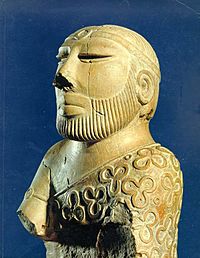
The region is named after the river Sindhu (Indus). The people living in the region are referred to as Sindhi. The terms Hindi and Hindu are derived from the word Sindh and Sindhu, as the ancient Persians pronounced "s" as "h" (e.g., sarasvati as harahvati). In the same way, Persians called the people of this region as Hindhu people, their language as Hindhi language and the region as Hindh, the name which is used for this region since ancient times, and later for the whole northern part of the Indian sub-continent today.
The Ror dynasty was a power from the Indian subcontinent that ruled modern-day Sindh and northwest India from 450 BC – 489 AD. The two main and highest ranked tribes of Sindh are the Soomro — descendants of the Soomro Dynasty, who ruled Sindh during 970–1351 A.D. — and the Samma — descendants of the Samma Dynasty, who ruled Sindh during 1351–1521 A.D. These tribes belong to the same blood line. Among other Sindhi Rajputs are the Bhachos, Bhuttos, Bhattis, Bhanbhros, Mahendros, Buriros, Lakha, Sahetas, Lohanas, Mohano, Dahars, Indhar, Chachar, Dhareja, Rathores, Dakhan, Langah, Mahars etc. The Sindhi-Sipahi of Rajasthan and the Sandhai Muslims of Gujarat are communities of Sindhi Rajputs settled in India. Closely related to the Sindhi Rajputs are the Jats of Sindh, who are found mainly in the Indus delta region. However, tribes are of little importance in Sindh as compared to in Punjab and Balochistan. Identity in Sindh is mostly based on a common ethnicity.
Sindhi Muslims
With Sindh's stable prosperity and its strategic geographical position, it was subject to successive conquests by foreign empires. In 712 A.D., Sindh was incorporated into the Caliphate, the Islamic Empire, and became the ‘Arabian gateway’ into India (later to become known as Bab-ul-Islam, the gate of Islam).
Muslim Sindhis tend to follow the Sunni Hanafi fiqh with a substantial minority being Shia Ithna 'ashariyah. Sufism has left a deep impact on Sindhi Muslims and this is visible through the numerous Sufi shrines which dot the landscape of Sindh.
-
Interior of the Shah Jahan Mosque, Thatta, built during the rule of the Mughal Empire.
Sindhi Hindus
Hinduism was the predominant religion in Sindh before Islamic conquest. According to the 1998 census of Pakistan, Hindus constituted about 8% of the total population of Sindh province. Most of them live in urban areas such as Karachi, Hyderabad, Sukkur and Mirpur Khas. Hyderabad is the largest centre of Sindhi Hindus in Pakistan, with 100,000–150,000 living there. The ratio of Hindus was higher before the independence of Pakistan in 1947.
Before 1947 however, other than a few Gujarati speaking Parsees (Zorastrians) living in Karachi, virtually all the inhabitants were Sindhis, whether Muslim or Hindu at the time of Pakistan's independence, 75% of the population were Muslims and almost all the remaining 25% were Hindus.
Hindus in Sindh were concentrated in the cities before the creation of Pakistan in 1947, during which many migrated to India according to Ahmad Hassan Dani. Hindus were also spread over Sindh province. Thari (a dialect of Sindhi) is spoken in Sindh in Pakistan and Rajasthan in India.
The Cities and towns of Sindh were dominated by the Hindus. In 1941, for example, Hindus were 64% of the total urban population.
Emigration
The Sindhi diaspora emigrated from India and Pakistan is significant. Emigration from the Sindh began before and after the 19th century, with many Sindhis settling in Europe, United States and Canada with a large Sindhi population Middle Eastern states such as the United Arab Emirates and the Kingdom of Saudi Arabia.
Culture
Sindhi names
Muslim Sindhi tend to have traditional Muslim first names, sometimes with localized variations. Sindhi have castes according to their professions and ancestral locations.
Sindhi Hindus tend to have surnames that end in '-ani' (a variant of 'anshi', derived from the Sanskrit word 'ansha', which means 'descended from'). The first part of a Sindhi Hindu surname is usually derived from the name or location of an ancestor. In northern Sindh, surnames ending in 'ja' (meaning 'of') are also common. A person's surname would consist of the name of his or her native village, followed by 'ja'.
Images for kids
-
Interior of the Shah Jahan Mosque, Thatta, built during the rule of the Mughal Empire.
-
Zulfiqar Ali Bhutto, ninth prime minister of Pakistan
-
Fahad Mustafa, Sindhi actor in Lollywood
-
Abida Parveen, notable Sufi musician
See also
 In Spanish: Pueblo sindi para niños
In Spanish: Pueblo sindi para niños


